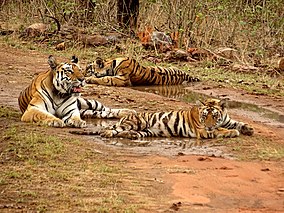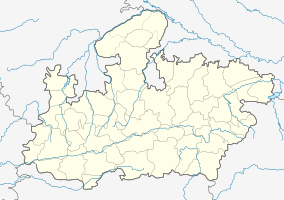Panna National Park
| Panna National Park | |
|---|---|
| Panna Biosphere reserve | |
 Bengal tigers at Panna National Park | |
| Location | Panna and Chhatarpur districts, Madhya Pradesh, India |
| Nearest city | Panna, Khajuraho (25 km (16 mi)) |
| Coordinates | 24°43′49.6″N 80°0′38.8″E / 24.730444°N 80.010778°E |
| Area | 542.67 km2 (209.53 sq mi) |
| Established | 1981 |
| Visitors | 22,563 (in 2009) |
| Governing body | Government of India, Ministry of Environment and Forests, Project Tiger, Madhya Pradesh |
Panna National Park is a national park located in Panna and Chhatarpur districts of Madhya Pradesh in India. It has an area of 542.67 km2 (209.53 sq mi). It was declared in 1994 as the twenty second Tiger reserve of India and the fifth in Madhya Pradesh,[1] Panna was given the Award of Excellence in 2007 as the best maintained national park of India by the Ministry of Tourism of India.[1] It is notable that by 2009, the entire tiger population had been eliminated by poaching with the collusion of forest department officials.[2]
Biome[edit]
Panna National Park and the surrounding territorial forest area of North and South Panna forest division is the only large chunk of wildlife habitat remaining in North Madhya Pradesh in the otherwise deciduous fragmented forest landscape of the region.
The National Park is situated at a point where the continuity of the Tropical and subtropical dry broadleaf forests belt, which starts from Cape Comorin in South India, is broken and beyond this the Upper Gangetic Plains moist deciduous forests of the great Indo-Gangetic Plain begins. This area is the northernmost tip of the natural teak forests and the easternmost tip of the natural 'Kardhai' Anogeissus pendula forests.
The forests of Panna National Park along with Ken Gharial Wildlife Sanctuary and adjoining territorial divisions form a significant part of the catchment area of the 406 km (252 mi) Ken River which runs northeast for about 72 km (45 mi) through the park.[1]
Fauna[edit]
Among the animals found here are the tiger, leopard, chital, chinkara, nilgai, sambhar and sloth bear. The park is home to more than 200 species of birds including the bar-headed goose, honey buzzard, king vulture, blossom-headed parakeet, changeable hawk-eagle and Indian vulture.
Tiger reserve[edit]
Panna National Park was declared as one of the Tiger reserves of India in 1994/95 and placed under the protection of Project Tiger.[3][4] The decline of tiger population in Panna has been reported several times.[5][6][7] Two female tigers were relocated there from Bandhavgarh National Park and Kanha National Park in March 2009. However, the last male tiger had already disappeared.[8] A committee to look into the disappearance of the tigers was formed.[9]
In June 2009, it was officially announced that the Reserve, which had over 40 tigers six years earlier, had no tigers left and only two tigresses, which were brought in a little earlier[10] In February 2012, only three years later, the entire tiger population of the reserve was considered eliminated. The Madhya Pradesh government did not determine responsibility for the debacle, nor did it pass the inquiry to the Central Bureau of Investigation in spite of requests from the Ministry of Environment and Forests and the Prime Minister's Office.[11]
The Ministry of Environment and Forests (MoEF) approved a proposal to translocate two tigers and two tigresses to the reserve.[12] One female each from Bandhavgarh National Park (coded T1) and Kanha National Park (T2) were translocated to Panna Tiger Reserve.[13] A tiger male, coded T3, was brought from Pench Tiger Reserve but strayed out of the park shortly thereafter, in November 2009[14] The tiger started walking towards its home in Pench National Park, indicating homing instinct. It moved steadily through human dominated landscape without causing any conflict. Forest department staff tracked it continuously for over a month and finally brought it back to the Panna Tiger Reserve. It then settled well, established territory and started mating. The tigress, T1, translocated from Bandhavgarh National Park, gave birth to four cubs in April 2010 of which 2 survive till date.[13] The second tigress, T2, translocated from Kanha National Park gave birth to four cubs several months later and all four survive till date.[13] A third tigress, coded T4, an orphaned cub was reintroduced to Panna in March 2011.[15] She learnt hunting skills with the help of the male and mated with him. She was found dead on 19 September 2014 of an infection caused by its radio collar.[16] Her sister T5 was released in Panna in November 2011. [13] Thus four tigers and around 10 cubs of up to 2 years are settled in Panna Tiger Reserve at present and their progress is being regularly monitored by the Forest Department.
Effect of Ken Betwa River Linking Project[edit]
The Government of India along with Government of Madhya Pradesh and Government of Uttar Pradesh have planned to link the Ken River with Betwa River. This involves construction of 283m long Daudhan Dam. The project aims to transfer excess water from Ken basin to Betwa basin thus provide water access to the drought prone region of Bundelkhand.
This construction will cause inundation of 400 hectares of land of 4300 hectare Panna Tiger reserve. Environmentalist are afraid that this will adversely affect the population of tigers in the region.[17]
References[edit]
- ↑ 1.0 1.1 1.2 Field Director, Panna Tiger Reserve. "The Park". Welcome to the official website of Panna Tiger Reserve. Forest department of Madhya Pradesh. Retrieved 7 February 2012.
- ↑ "Poaching nexus exposed". The Statesman. The Statesman Limited. 31 October 2011. Archived from the original on 3 January 2003. Retrieved 7 February 2012.
- ↑ Cabinet approves 5 new Tiger reserve, Live India, 13 January 2011, archived from the original on 18 February 2012
- ↑ "LIST OF TIGER RESERVES IN INDIA" (PDF), Stripes, New Delhi: Inder Mohan Singh Kathuria on behalf of National Tiger Conservation Authority, Government of India, vol. 2, no. 2, p. 19, January–February 2011, retrieved 21 June 2011[permanent dead link]
- ↑ Panna National Park nearest airport, letsuppro, 18 May 2009
- ↑ "PANNA NATIONAL PARK, LOCATED ABOUT". letsuppro. India. 24 February 2008. Retrieved 8 September 2019.
- ↑ "The main attraction of Panna National Park". Retrieved 14 May 2009.
- ↑ "Govt orders probe into missing Panna tiger". The Times of India. 28 March 2009. Archived from the original on 23 October 2012. Retrieved 18 October 2011.
- ↑ "Panel to look into disappearance of tiger". The Times of India. 9 May 2009. Archived from the original on 23 October 2012. Retrieved 18 October 2011.
- ↑ It's official: Panna reserve has no tiger The Times of India, 14 June 2009.
- ↑ Mahim Pratap Singh (7 February 2012). "CBI probe for Panna tiger debacle stuck at the lowest level". The Hindu. Bhopal. Retrieved 7 February 2012.
- ↑ "Centre clears translocation of 4 big cats to Panna". The Indian Express. India. 27 June 2009. Retrieved 18 October 2011.
- ↑ 13.0 13.1 13.2 13.3 Murthy, R. S. (2012). Panna Turnaround Story. Panna: Panna Tiger Reserve. p. 6.
- ↑ "Desperately tracking a stray tiger in Panna reserve". The Times of India. 21 December 2009. Archived from the original on 25 October 2012. Retrieved 18 October 2011.
- ↑ "Panna reserve gets another tigress". The Indian Express. India. 28 March 2011. Retrieved 18 October 2011.
- ↑ "Radio-collar infection kills tigress in MP". The Times of India. India. 20 September 2014.
- ↑ "article".

